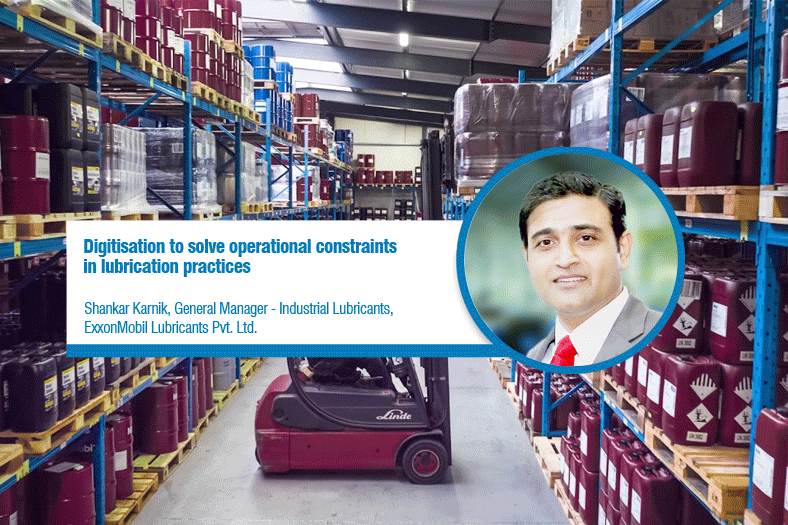Digitisation to solve operational constraints in lubrication practices
January 9, 2020 3:27 pm
With ExxonMobil’s MSLA programme, operators can now look forward to increased productivity and performance from their equipment.
Shankar Karnik, General Manager – Industrial Lubricants, ExxonMobil Lubricants Pvt. Ltd., discusses how IIoT and automation are transforming the industry, especially in lubrication sector, to improve operational efficiency.
How does the future look for Industrial Internet of Things (IIoT) in manufacturing?
IIoT has become the buzzword for many industries, ranging from telecom, logistics, manufacturing et al. As these industries evolve, the need for accelerating the efficiency and productivity of various operational processes is relatively rising.
Talking specifically about manufacturing, we see a lot of manufacturers adopting IIoT-enabled technologies. A recent survey, “Data’s Big Impact on Manufacturing”, revealed that 67 percent of the 200 manufacturing executives plan to invest significant resources in data analytics technology in the near future.
IIoT helps in catalysing and transforming various industrial operations. It is of paramount importance in bringing about the revolutionary benefits of predictive and proactive maintenance, real-time monitoring, resource optimisation, efficient diagnosis and much more. It enables a connected, smart manufacturing enterprise by enhancing decision making, increasing security and productivity, profitability as well as improving overall collaboration across the enterprise. It provides the right information at the right time to optimise operations.
Moreover, with the government laying impetus on domestic manufacturing during the 2018 budget announcement, entrepreneurs are being encouraged to lead more manufacturing ventures in the days to come.
Hence, given the promising offerings of IIoT and the overall government agenda of boosting the manufacturing sector, I foresee increased investments in IIoT-related technologies. It has become essential for the sector to invest in efficient technologies and automation solutions now, in order to be in sync with the dynamic needs of the new age customer.
Which industries will drive IIoT adoption in 2019?
According to a latest research, the Internet of Things (IoT) market is projected to grow at a CAGR of 28.2 percent during 2016–22. The Indian IoT market is largely dominated by Industrial IoT followed by Consumer IoT. Higher use of automation and data exchange in any specific industry will enhance efficiency, improve profitability, foster innovation, and allow smart management of safety, performance, and environmental impact. As a result, companies across India and the globe are increasingly turning to IIoT to avail these benefits. The IIoT segment, hence, is registering a remarkable growth.
The government’s “Digital India campaign” is also a driver in spreading awareness and adoption of IoT amongst end users.
With the mounting emphasis laid on factors such as operational efficiency, optimal outcomes, and effective resource management, multitudes of industries are deploying IIoT-aided automation technologies for their industrial units. These technologies bring together the physical and digital world to enable man and machine make informed, real-time decisions, delivering a safe, efficient and sustainable environment.
The sectors adopting IIoT technologies at a relatively faster rate include energy, manufacturing, plastics, steel, mining, and infrastructure as these sectors are the propellants of economic growth and development in the country.
Could you discuss about your company’s preparedness in this front?
ExxonMobilTM has always played a part in the progress of the industrial revolutions, where industrial lubrication ensured optimum equipment performance. For over 150 years, innovation has been our core focus in providing the best lubricant solutions for manufacturers, where ExxonMobil continues to make breakthrough innovations that redefine the power of lubrication.
One major issue that has been pertinent for the manufacturing sector is the performance of heavy-duty machinery. Lubricants play a crucial role in ensuring consistent protection and performance of equipment to minimise financial losses. That said, oil health analysis becomes a quintessential programme that ensures reduced downtime and increased reliability of equipment.
However, the traditional oil analysis process is laborious and costly, and may cause unscheduled downtime, production delays, and reduced operational efficiency. Furthermore, the diagnosis from the analysis could also impact their productivity, safety, and environmental goals.
Industrial lubricant and grease makers are, therefore, shifting towards digitised lubrication practices. ExxonMobil, with a long history of working with equipment manufacturers, worked to develop a modern, app-based platform. A model of ‘Mobil going Mobile’ was developed to reach every end user through a regular and convenient operational interface.
Mobil ServSM Lubricant Analysis (MSLA), a mobile-enabled used oil analysis programme, was launched in 2016. MSLA is designed to enhance efficiency and simplify the oil health analysis process by replacing a paperwork-heavy approach with a simple, intuitive, mobile-enabled service platform that reduces the number of steps involved in the used oil analysis process. MSLA is a solution that manufacturers need to take to move towards Industry 4.0 and digitisation.
The platform streamlines the entire oil analysis process — from initial sample gathering to final reporting, with QR-coded scan-and-go sampling bottles that deliver used oil samples to ExxonMobil’s oil analysis laboratory. Customers can also leverage application-specific analysis options that allow them to access results and perform customised equipment recommendations directly on their mobiles or tablet devices, saving them from unnecessary downtime that could affect production output and delivery deadlines.
With ExxonMobil’s MSLA programme, operators can now look forward to increased productivity and performance from their equipment — the analysis helps identify issues that can be mitigated with minimal downtime, reduce the amount of lubricant needed to operate machinery, and improve and extend overall machine life.
Cookie Consent
We use cookies to personalize your experience. By continuing to visit this website you agree to our Terms & Conditions, Privacy Policy and Cookie Policy.


















